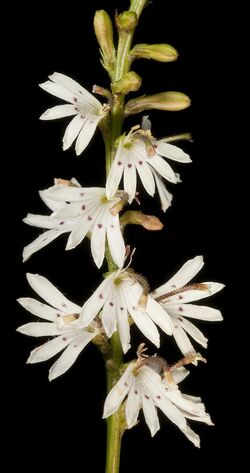Biology:Goodenia helmsii
| Goodenia helmsii | |
|---|---|

| |
| Scientific classification | |
| Kingdom: | Plantae |
| Clade: | Tracheophytes |
| Clade: | Angiosperms |
| Clade: | Eudicots |
| Clade: | Asterids |
| Order: | Asterales |
| Family: | Goodeniaceae |
| Genus: | Goodenia |
| Species: | G. helmsii
|
| Binomial name | |
| Goodenia helmsii (E.Pritz.) Carolin[1]
| |
| Synonyms[1] | |
|
Scaevola helmsii E.Pritz. | |
Goodenia helmsii is a species of flowering plant in the family Goodeniaceae and is endemic to inland parts of the south-west of Western Australia. It is an erect or ascending shrub with cylindrical stem leaves and spikes of white flowers with purplish spots.
Description
Goodenia helmsii is an erect or ascending shrub that typically grows to a height of 80 cm (31 in) tall and glabrous except for woolly hairs in the leaf axils. The leaves are linear, cylindrical 2–5 mm (0.079–0.197 in) long and about 0.5 mm (0.020 in) wide. The flowers are arranged in a spike or spike-like thyrse up to 120 mm (4.7 in) long with small bracts and bracteoles. The sepals are triangular, 0.5–0.7 mm (0.020–0.028 in) long, the corolla white with purplish spots, 4–5.5 mm (0.16–0.22 in) long with more or less equal lobes 1.5–2.5 mm (0.059–0.098 in) long with wings about 0.3 mm (0.012 in) wide. Flowering mainly occurs from July to December and the fruit is a more or less spherical nut about 1 mm (0.039 in) in diameter.[2][3]
Taxonomy and naming
This species was first formally described in 1905 by Ernst Georg Pritzel who gave it the name Scaevola helmsii.[4][5] In 1990 Roger Charles Carolin changed the name to Goodenia helmsii in the journal Telopea.[6][7] The specific epithet (helmsii) honours the naturalist Richard Helms.[8]
Distribution and habitat
This goodenia grows in gravelly or sandy soil in inland areas of the south-west, in the Avon Wheatbelt, Coolgardie, Jarrah Forest, Mallee, Murchison and Yalgoo biogeographic regions of Western Australia.[2][3]
Conservation status
Goodenia helmsii is classified as "not threatened" by the Government of Western Australia Department of Parks and Wildlife.[3]
References
- ↑ 1.0 1.1 "Goodenia helmsii". Australian Plant Census. https://biodiversity.org.au/nsl/services/apc-format/display/118296.
- ↑ 2.0 2.1 Carolin, Roger C.. "Goodenia helmsii". Australian Biological Resources Study, Department of Agriculture, Water and the Environment: Canberra. https://profiles.ala.org.au/opus/foa/profile/Goodenia%20helmsii.
- ↑ 3.0 3.1 3.2 "Goodenia helmsii". FloraBase. Western Australian Government Department of Parks and Wildlife. https://florabase.dpaw.wa.gov.au/browse/profile/12523.
- ↑ "Scaevola helmsii". APNI. https://id.biodiversity.org.au/instance/apni/541624.
- ↑ Diels, Ludwig (ed.); Pritzel, Ernst Georg (1904). "Fragmenta Phytographiae Australiae occidentalis. Beitrage zur Kenntnis der Pflanzen Westaustraliens, ihrer Verbreitung und ihrer Lebensverhaltnisse". Botanische Jahrbücher für Systematik, Pflanzengeschichte und Pflanzengeographie 35 (2): 545–546. https://www.biodiversitylibrary.org/item/660#page/637/mode/1up. Retrieved 13 February 2021.
- ↑ Carolin, Roger C. (1990). "Nomenclatural notes and new taxa in the genus Goodenia (Goodeniaceae)". Telopea 3 (4): 520. doi:10.7751/telopea19904905. https://www.biodiversitylibrary.org/item/265128#page/74/mode/1up. Retrieved 13 February 2021.
- ↑ "Goodenia helmsii". APNI. https://id.biodiversity.org.au/instance/apni/552573.
- ↑ Sharr, Francis Aubi; George, Alex (2019). Western Australian Plant Names and Their Meanings (3rd ed.). Kardinya, WA: Four Gables Press. p. 215. ISBN 9780958034180.
Wikidata ☰ Q17480020 entry
 |


